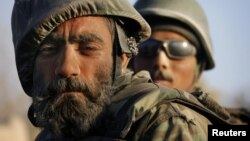On paper, the Afghan National Army (ANA) looks strong enough to secure the country almost immediately.
The force had a listed strength of 173,000 personnel in October and should reach 195,000 soldiers by the end of 2013.
That means that by the end of next year it will be 1 1/2 times the size of the 130,000-strong International Security Assistance Force deployed in Afghanistan today.
But if the ANA is now a large force after years of slow growth, its level of training and effectiveness is less certain. And as political pressure grows in the United States for a more rapid drawdown of forces in Afghanistan, a key question is how soon the Afghan National Army will be ready to defend the country by itself.
A report on the army and police issued in June 2010 by the U.S. office of the special inspector-general for Afghan reconstruction revealed widespread absenteeism, corruption, and drug abuse among the Afghan forces.
The report suggested that only 23 percent of Afghan soldiers were capable of working unsupervised and found that in the month before the report was issued 12 percent of the army had been absent without leave.
Since then, there have been improvements.
'Really Good Job'
The NATO Training Mission-Afghanistan (NTM-A) said in August 2011 that the quality of recruits and retention is improving following a pay raise and improvements in the ANA's payroll system.
The NTM-A said between 90 and 95 percent of new recruits are able to pass a weapon-qualification test after graduating from basic training. That compares to just 25 percent a year earlier.
"The army in particular has done a really good job in getting recruits in," says Joshua Foust, a regional expert at the American Security Project in Washington. "The challenge with that is that even though they are better than they were in 2008 or 2009, you still don't have a lot of units that can operate independently."
He says Afghan forces are increasingly doing their own sweep operations in areas under their control but that they remain dependent upon foreign forces in multiple ways.
"They are completely reliant on the United States or on NATO for the logistics, for their planning, for their intelligence, for their air support, for their quick-response forces if they get into trouble," Foust says. "So there are a lot of ways in which there is the illusion or appearance of their being self-sufficient when they are really not."
Top U.S. commanders in Afghanistan acknowledge the overall level of the Afghan National Army remains far from that of Western standards.
But they say the level of the ANA's special forces is constantly improving and that it is those forces that are the key to fighting a successful counterinsurgency.
"Will [the ANA] be at the standard that we have for our soldiers? No -- not, at least, the conventional forces," Lieutenant General Curtis Scaparrotti, the deputy commander of U.S. Forces-Afghanistan, said last month. "Their response forces we're training, their [Special Operations Forces], the commandos, are being trained to a very high level. And I think that's one thing that's a bright picture here for them is that their response forces are really coming along very well. And that will be...quite an asset for the country here in the future."
Taliban Infiltration
A very different problem the ANA faces is infiltration by the Taliban.
About 70 members of the NATO-led force were killed in 42 insider attacks from May 2007 through the end of January 2012. The killings show the Afghan National Army has yet to develop an effective vetting system for keeping sleeper agents out.
As General Abdul Hameed, the top army commander for the southern region of Afghanistan, said earlier this month, "Placing the rogues inside the army is well-planned by the enemies. The Taliban give them special training."
He said preventing infiltration will require far better intelligence to indentify suspects and prevent them from enlisting.
All this makes predicting whether the ANA will be able to defend Afghanistan a bit like trying to determine whether a glass is half full or half empty.
Optimists can take heart from the fact that international forces have been able to steadily hand over security responsibility to the ANA, with about half of the country's population now living in areas the ANA controls.
Pessimists can point to the fact that the most conflict-ridden areas remain the responsibility of foreign forces, particularly in the east and south.
What both viewpoints can agree on is that the true test for the ANA has yet to come, and that when it does, the future of Afghanistan will hinge upon the result.
The force had a listed strength of 173,000 personnel in October and should reach 195,000 soldiers by the end of 2013.
That means that by the end of next year it will be 1 1/2 times the size of the 130,000-strong International Security Assistance Force deployed in Afghanistan today.
But if the ANA is now a large force after years of slow growth, its level of training and effectiveness is less certain. And as political pressure grows in the United States for a more rapid drawdown of forces in Afghanistan, a key question is how soon the Afghan National Army will be ready to defend the country by itself.
A report on the army and police issued in June 2010 by the U.S. office of the special inspector-general for Afghan reconstruction revealed widespread absenteeism, corruption, and drug abuse among the Afghan forces.
The report suggested that only 23 percent of Afghan soldiers were capable of working unsupervised and found that in the month before the report was issued 12 percent of the army had been absent without leave.
Since then, there have been improvements.
'Really Good Job'
The NATO Training Mission-Afghanistan (NTM-A) said in August 2011 that the quality of recruits and retention is improving following a pay raise and improvements in the ANA's payroll system.
The NTM-A said between 90 and 95 percent of new recruits are able to pass a weapon-qualification test after graduating from basic training. That compares to just 25 percent a year earlier.
"The army in particular has done a really good job in getting recruits in," says Joshua Foust, a regional expert at the American Security Project in Washington. "The challenge with that is that even though they are better than they were in 2008 or 2009, you still don't have a lot of units that can operate independently."
He says Afghan forces are increasingly doing their own sweep operations in areas under their control but that they remain dependent upon foreign forces in multiple ways.
"They are completely reliant on the United States or on NATO for the logistics, for their planning, for their intelligence, for their air support, for their quick-response forces if they get into trouble," Foust says. "So there are a lot of ways in which there is the illusion or appearance of their being self-sufficient when they are really not."
Top U.S. commanders in Afghanistan acknowledge the overall level of the Afghan National Army remains far from that of Western standards.
But they say the level of the ANA's special forces is constantly improving and that it is those forces that are the key to fighting a successful counterinsurgency.
"Will [the ANA] be at the standard that we have for our soldiers? No -- not, at least, the conventional forces," Lieutenant General Curtis Scaparrotti, the deputy commander of U.S. Forces-Afghanistan, said last month. "Their response forces we're training, their [Special Operations Forces], the commandos, are being trained to a very high level. And I think that's one thing that's a bright picture here for them is that their response forces are really coming along very well. And that will be...quite an asset for the country here in the future."
Taliban Infiltration
A very different problem the ANA faces is infiltration by the Taliban.
About 70 members of the NATO-led force were killed in 42 insider attacks from May 2007 through the end of January 2012. The killings show the Afghan National Army has yet to develop an effective vetting system for keeping sleeper agents out.
As General Abdul Hameed, the top army commander for the southern region of Afghanistan, said earlier this month, "Placing the rogues inside the army is well-planned by the enemies. The Taliban give them special training."
He said preventing infiltration will require far better intelligence to indentify suspects and prevent them from enlisting.
All this makes predicting whether the ANA will be able to defend Afghanistan a bit like trying to determine whether a glass is half full or half empty.
Optimists can take heart from the fact that international forces have been able to steadily hand over security responsibility to the ANA, with about half of the country's population now living in areas the ANA controls.
Pessimists can point to the fact that the most conflict-ridden areas remain the responsibility of foreign forces, particularly in the east and south.
What both viewpoints can agree on is that the true test for the ANA has yet to come, and that when it does, the future of Afghanistan will hinge upon the result.















